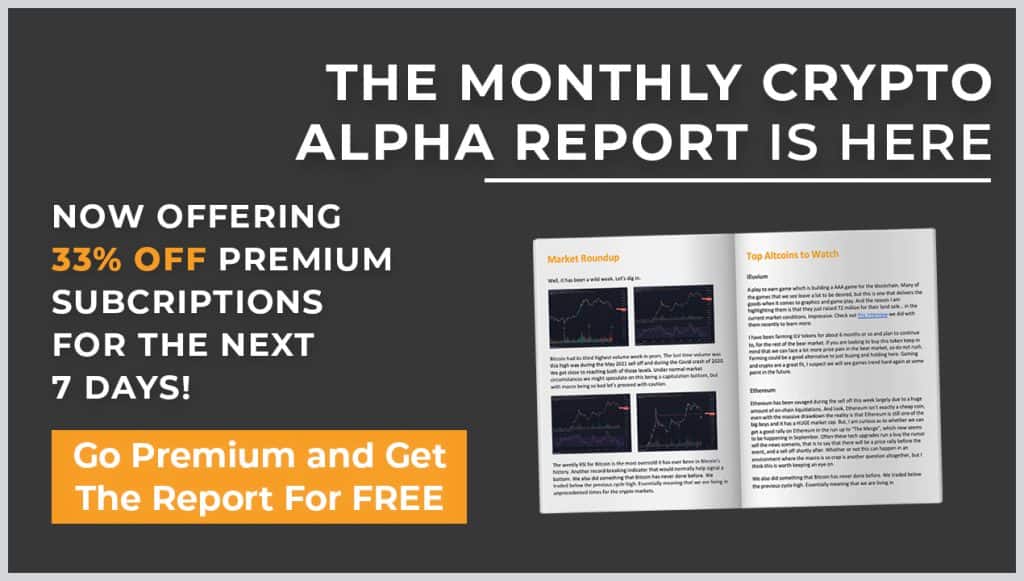The Team from Cronos & Future Use Cases for DeFi

In This Issue
- The team from Cronos discusses some cool new projects.
- Erik has a report for you on the future use cases for DeFi.
REMINDER: 33% Discount to go Premium!
Hey, before jumping into the Newsletter, I wanted to kindly remind you of the discount that we’re offering!
Right now, you can become a Premium Subscriber of the Wealth Mastery Newsletter for:
$3926$ / Month – During The First 3 Months!$199133$ / 6 Months
That’s right… you essentially get TWO months for FREE if you get the 6 month membership!
Unlock full access to the most value packed crypto newsletter on the market right now!
Cronos Inverview
Interview with Ken Timsit, Managing Director of Cronos
<h3 id="for-anyone-not-familiar,-what-is-cronos? “>For anyone not familiar, what is Cronos?Cronos is the 7th largest blockchain network in the world as measured by total value locked in DeFi protocols.
It is the first EVM-compatible (EVM = Ethereum Virtual Machine) chain built with Cosmos technology, which means that it is able to interoperate with Ethereum and Cosmos, the two leading ecosystems for decentralized applications.
Cronos is not an attempt to create yet another so-called “Ethereum killer” from scratch.
Our vision is to move beyond the blockchain wars and create an ecosystem of start-ups and end-users who can leverage the best modules from Ethereum, Cosmos, and other open-source communities.
Our approach is all about interoperability and cooperation.
Crypto.com, the world’s fastest-growing crypto exchange with 50+ million users globally, is aligned with this philosophy and that is why they are a strategic partner of Cronos.
Crypto.com is contributing to our open-source development and supporting the Cronos ecosystem through their product integrations.
When startup founders and developers build on Cronos, they can leverage:
- Wrapped versions of the world’s top 50 cryptocurrencies
- 18 leading self-custodial crypto wallets (including MetaMask, Crypto.com Defi Wallet, and Trust Wallet)
- Ethermint, an Ethereum Virtual Machine module built by the open-source Cosmos SDK community.
- IBC (Inter Blockchain Communication) cross-chain connectivity to Cosmos chains
- All Ethereum developer tools (Solidity, Truffle, Hardhat, OpenZeppelin, Web3.js, ethers.js, ChainSafe Gaming SDK, etc.)
- Several leading cloud infrastructure providers and indexers (Blockdaemon, Moralis, Covalent, RockX)
- Cronos Play, a suite of tools for web, Unity, Unreal, and C++ game developers
- And a rich ecosystem of 300+ composable DeFi and GameFi Dapps.
The token is now named Cronos (symbol: $CRO).
It is the utility token that powers the economy of the Cronos ecosystem. Practically, it is the token used by end-users to pay for the modest transaction fees on Cronos, and it is also used as the base cryptocurrency for many decentralized finance applications in the Cronos ecosystem.
The health of the Cronos ecosystem underpins the utility of the Cronos ($CRO) token.
Our main success indicators are the number of users on Cronos (already close to 1 million), the number of daily transactions (averaging between 200,000 and 300,000), the total value locked in DeFi protocols (exceeded 4 billion USD in April 2022), and the number of applications on Cronos (more than 300).
Additionally, the $CRO continues to be the utility and proof-of-stake token of the Crypto.org Chain, another Cosmos chain that is used by Crypto.com and others to enable loyalty rewards, crypto-payments, cheap NFT minting, and other use cases that require high transaction speed.
<h3 id="crypto.com-is-a-giant-in-the-crypto-industry,-so-to-what-extent-are-they-supporting-cronos? “>Crypto.com is a giant in the crypto industry, so to what extent are they supporting Cronos?Crypto.com has a history of contributing to open-source blockchain technology and they are a major contributor to the Cronos code base.
Their talented blockchain developers, protocol engineers, and security researchers are bringing tremendous value added to the project.
Secondly, Crypto.com believes in decentralization and they want to empower users with the tools needed to experience the full promise of self-custody of crypto-assets, beyond what is available from within their platform.
The self-custodial Crypto.com DeFi Wallet is a good example of such a tool.
Hence, Crypto.com is participating in a virtuous circle that benefits the Cronos ecosystem: they are making it easy for their 50 million users to use decentralized applications on Cronos, which makes the Cronos chain attractive for third-party application developers, which results in higher quality DeFi and GameFi apps that attract even more users to Cronos.
Finally, Crypto.com is investing in the broader crypto start-up ecosystem via their 500M USD venture capital arm, Crypto.com Capital.
These investments are not targeted specifically at Cronos but as one of the top ecosystems for DeFi and GameFi start-ups, Cronos benefits its fair share.
<h3 id="what-are-some-examples-of-applications-currently-running-on-cronos? “>What are some examples of applications currently running on Cronos?The top DeFi applications are the core primitives you would expect to find on any of the leading chains: decentralized exchanges like VVS, Ferro, and MM Finance, and decentralized lending protocols such as Tectonic and Mimas Finance.
In addition to these primitives, a range of other applications aims to make it easier for end-users to optimize the yield on their cryptos: Single Finance with their pseudo-market-neutral strategy, Beefy Finance with their multi-chain yield optimizer, and Autofarm with their yield aggregator.
On the NFT, GameFi, and Metaverse side, we can find Ebisu’s Bay, the top NFT marketplace on Cronos and one of the leading marketplaces across all chains.
DG Pals is a popular game; it is a puppy-themed blockchain game that allows players to use their NFTs for quests and battles.
There are more than 10 other significant games in development, and we expect more to come, given that our Cronos Accelerator Program, backed by a 100M USD fund, and the hackathon we are sponsoring with Moralis currently, both have a big focus on gaming and NFTs.
<h3 id="what-are-you-doing-for-interoperability? “>What are you doing for interoperability?Cronos is interoperable with all other Ethereum-compatible chains at the protocol level.
Developers can take any application they have developed for Ethereum, Binance Smart Chain, Polygon, Avalanche, Arbitrum, Optimism, and others and quickly deploy the same smart contracts to Cronos.
When transferring tokens to and from Cronos, the safest and most convenient way is via a Crypto.com account, which connects to all the important chains and supports all the leading cryptocurrencies on Cronos.
We have recently started testing the Cronos Gravity Bridge, poised to become the canonical token bridge between Cronos and Ethereum mainnet. It will be available to end-users soon. Meanwhile, there are independent bridges connecting Cronos to other EVM chains, such as Connext.
Finally, Cronos supports IBC (Inter Blockchain Communication), a safe protocol to transfer cryptocurrencies between Cosmos chains. Cronos is currently connected to Cosmos Hub and Akash, and we are very open to supporting more channels whenever there is demand.
<h3 id="obviously,-the-layer-one-space-is-very-competitive,-what-is-cronos-doing-to-capture-market-share? “>Obviously, the layer one space is very competitive, what is Cronos doing to capture market share?In the current bear market, users and developers value consistency and reliability. Cronos is already a leading chain, and, with Crypto.com’s support, it is here to stay. We will continue building for years, and it will pay off.
Regarding end-users, our primary focus is on easy fiat to crypto on-ramp and ease of use. The integration with Crypto.com and their 50 million users, as well as with 18 wallets and counting, is helping tremendously. I find it much easier to add crypto to my self-custodial wallet on Cronos than on any other chain.
When it comes to application developers, if they are practically minded, they value this addressable user base immensely as a unique selling point of Cronos.
We believe that the best thing we can do for them is to help put their applications in the hands of users so that they can collect feedback and achieve product/market fit.
We also have developer support programs, such as the Cronos Ecosystem Grants and the Cronos Accelerator Program, backed by a 100M USD ecosystem fund.
<h3 id="what-comes-next-for-cronos? “>What comes next for Cronos?We will continue to invest in the protocol and infrastructure to make it faster, cheaper, and more eco-friendly.
On the DeFi side, we encourage start-ups to create trading and lending protocols that are more capital efficient and sustainable long-term without relying so much on early adopter incentives.
On the GameFi side, we have made many partnerships and integration announcements recently: Unity, Unreal, ChainSafe, Moralis, DG Pals, Binemon, Demole, Dragon SB, Revolve Games, Decentral Games, Dexi, etc. I am now looking forward to the actual product launches in the coming weeks.
Ultimately, Cronos aims at being a bridge between disparate blockchain ecosystems in order to facilitate the mainstream adoption of Web3.
Future Use Cases for DeFi by Erik
The great thing about DeFi is that it’s a sandbox where everyone can play. Also, the problem with DeFi is that it’s still mostly a sandbox where people play with toy tokens. There is little connection to the ‘real world’. This will change, though. What are future use cases for DeFi that could catapult it into the mainstream and kick off the next bull market?
Let’s discuss some encouraging findings.
First, DeFi has proven itself during multiple 50% plus downturns over the past two years. At least, from a technological point of view.
The systems stayed up, and the pipelines didn’t clog. Users could deposit and withdraw just fine on lending apps like Aave and Compound. The Total Value Locked (TVL) in DeFi has dropped from 200 billion to 70 billion since the Terra ecosystem crash. Yet this did not lead to any major problems (relatively minor exceptions being the Solend and Bancor issues).
Compare this to some of their Centralized Finance counterparts, that faced huge solvency problems and had to close shop.
Second, arguably the most solid use case of DeFi, namely stablecoins, is still firmly standing. Setting aside for a second the crash of algorithmic stablecoin UST, the stablecoin market hasn’t crashed: it has held up fine.
Now, let’s address some criticism about DeFi. Inflationary tokenomics caused a huge boom and subsequent bust.
Clearly, insane yield farming APY’s were not sustainable. Sure, it might have been a profitable strategy to get in quickly after the launch of a new DeFi protocol and sell that initial wave of farming tokens. But the crash of token prices would come sooner or later. And indeed they crashed. Busted.
Real-World Assets on Chain: An explosive growth market
So is DeFi dead? No. First of all, the talent is still there and the venture capital is still there. The question now becomes, will DeFi come up with future use cases that justify these?
For that to happen, DeFi has to bring Real-World Assets (RWA’s) on-chain. Mass adoption will only happen if we go beyond the sandbox and large numbers of people will want to use this technology for everyday use cases.
The DeFi sandbox has proven what it is good for. Namely to create global and liquid markets for tokens that didn’t exist a blink of an eye ago – but weren’t necessarily backed by anything valuable.
Now, combine this with the fact that many things in ‘the real world’ have no such access to liquid markets, but do have actual value.
Just consider the chemical reaction – no, the explosion – that combining these two elements could cause? How about tokenizing real-world assets? Making things tradable that hitherto were not tradable? Mind …. blown.
1. Utility tokens for businesses
Utility tokens are a new way in which companies can hand out value to their customers. It’s like owning a piece of the product (a real-world asset).
That piece is tradable on secondary markets AND redeemable for (a part of) the product. In a good article on her website, Tascha Che discusses what utility tokens could mean for businesses that adopt them. What role could they fulfill? Examples are:
- Loyalty programs: traditionally, reward tokens (frequent flyer miles, credit card points, etc) could only be exchanged for products. Tokenizing these would incentivize users to earn rewards since these rewards wouldn’t be confined any longer to the walled garden of the brand. They can be cashed out immediately.
- Funding growth marketing: to a company, issuing utility tokens is like giving away equity. It’s a way to use future (unrealized) revenues to fund growth today. And without bleeding your cash reserves.
The difference between utility tokens for ‘real’ businesses and current DeFi projects is that people will want to own the utility tokens of a business for their own sake. They don’t hold them just for the expectation of rapid price appreciation. A stable price is better.
2. Uncollateralized debt on-chain
This is a huge growth market. The off-chain market for loans is giant and consists mostly of uncollateralized loans. In other words, most people loan against their future income, not against their assets. Yet, the latter is how the current loan market in crypto works: it’s mostly collateralized loans.
Compare it to a pawn shop, where you put up your golden necklace as collateral for your loan in dollars. (Why do people even borrow with collateral in DeFi? For example, they hold bitcoin and need dollars without wanting to give up their bitcoin.) There is a reason that banks are a bigger industry than pawn shops: there simply isn’t that much demand for uncollateralized loans.
So to grow, DeFi has to find a way to capture a slice of that uncollateralized loan market. Protocols such as Maple Finance (MPL) and Goldfinch (GFI) are already venturing there.
Goldfinch created a lending model that introduces a third party besides the borrower and lender. This is a group of users who assess the creditworthiness of the borrower.
To incentivize their best effort, this group puts money on the line themselves.
Goldfinch’s biggest challenge is assembling such a pool of good credit evaluators. Currently, it is still Goldfinch’s team that assesses the creditworthiness of prospective borrowers.
Let’s wait and see how this market develops. There is a chance that the next bull run will be kicked off with on-chain, undercollateralized credit products. After ICO’s (2017) and yield farming tokens (2020), it might be the token distribution mechanism of the next crypto boom.
3. Highly experimental use case: DeSci
Beyond the above two prime examples of huge markets that could be disrupted by DeFi, there are tons of other markets smaller in size. To name one: DeSci (Decentralized Science). Science is another field waiting to be disrupted by decentralization. Currently, the industry intermediaries hold a lot of power.
Still in its infancy, DeSci would give the scientific community a tool to change how research is funded, knowledge is shared and who will own the fruits of the scientific labor.
As an example, Packy McCormick has talked about Vibe Bio, a start-up that will create DAOs that fund research and drug development for rare diseases.
It aligns a community of patients and scientists to get treatments funded that wouldn’t be worth the trouble for big pharma. Why a DAO instead of a kickstarter? Because of the ability to tap into crypto’s global funding market.
Conclusion
View the DeFi boom of 2020-2022 as a successful proof-of-concept. Now let’s see how these shiny new DeFi tools will be applied beyond the sandbox and into the real world. It will be a thrill to watch!
Final Notes
If you’ve enjoyed the Newsletter so far, please keep in mind that you can unlock access to the rest of it by upgrading your subscription on a 33% discount!
From June 2022, premium members will also get the Monthly Crypto Alpha Report for FREE. It includes:
- Market analysis that I don’t usually reveal on social media.
- My Investment Strategies (what I’m buying and selling)
- Top airdrops of the month to get free $$$
- Top altcoins of the month to invest in
- And top DeFi Protocols to stay safe during the bear market

See you next time!
Lark and the Wealth Mastery Team
Legal Disclaimer
TCL Publishing ltd (director Lark Davis, owner of Wealth Mastery) is not providing you individually tailored investment advice. Nor is TCL Publishing registered to provide investment advice, is not a financial adviser, and is not a broker-dealer. The material provided is for educational purposes only. TCL Publishing is not responsible for any gains or losses that result from your cryptocurrency investments. Investing in cryptocurrency involves a high degree of risk and should be considered only by persons who can afford to sustain a loss of their entire investment. Investors should consult their financial adviser before investing in cryptocurrency.




Responses